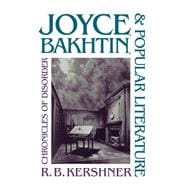
Note: Supplemental materials are not guaranteed with Rental or Used book purchases.
Purchase Benefits
What is included with this book?
| Acknowledgments | p. ix |
| Abbreviations in the Text | p. xi |
| Joyce, Bakhtin, and the Canon | p. 1 |
| Joyce and Popular Literature | p. 1 |
| Adolescent Attitudes | p. 2 |
| Joyce, the Press, and Popular Writing | p. 4 |
| The Problematics of Popularity | p. 8 |
| Bakhtin's Dialogism | p. 15 |
| Young Dubliners: Popular Ideologies | p. 22 |
| "The Sisters": Breaking the Silence | p. 22 |
| "An Encounter": Boys' Magazines and the Pseudo-Literary | p. 31 |
| "Araby": Varieties of Popular Romance | p. 46 |
| "Eveline": Bourgeois Drama and Pornography | p. 60 |
| "After the Race": Modern Musketeers | p. 71 |
| "Two Gallants": The Ideology of Gallantry | p. 79 |
| "The Boarding House": The Rhetoric of Oxymoron | p. 89 |
| Older Dubliners: Repetition and Rhetoric | p. 94 |
| Stories of Maturity | p. 94 |
| "A Little Cloud": Exclusion and Assimilation | p. 96 |
| "Counterparts": Obsessive Repetition | p. 101 |
| "Clay": Repetition and Dialogism | p. 104 |
| "A Painful Case": The Rhetoric of Disembodiment | p. 110 |
| Stories of Public Life | p. 117 |
| "Ivy Day in the Committee Room": Consensus and Group Fantasy | p. 118 |
| "A Mother": Economic and Social Rhetoric | p. 124 |
| "Grace": Periphrasis and the Unspeakable | p. 130 |
| "The Dead": Women's Speech and Tableau | p. 138 |
| A Dialogical Portrait | p. 151 |
| Dialogical Variations | p. 151 |
| Dialogism and Incremental Repetition | p. 154 |
| Stephen's Schooldays | p. 165 |
| Tom Brown's School-Days | p. 168 |
| Eric, or Little by Little and The Harrovians | p. 176 |
| Vice-Versa | p. 180 |
| Romantic Image | p. 185 |
| A Modern Daedalus | p. 190 |
| The Count of Monte Cristo | p. 195 |
| Romantic Precursors | p. 209 |
| A Portrait of the Artist as Text | p. 216 |
| Stephen's Reading: Allusive Dialogism | p. 216 |
| Peter Parley's Tales | p. 216 |
| Ingomar the Barbarian and The Lady of Lyons | p. 221 |
| Joyce's Reading: Elusive Dialogism | p. 227 |
| The Ideology of an Aesthete: Havelock Ellis and The New Spirit | p. 227 |
| Portraits of Artists and Others | p. 233 |
| Sex/Love/Marriage: Portrait, Stephen Hero, and Exiles | p. 253 |
| The Discourse of Sexuality and Marriage | p. 253 |
| Charles Albert: L'Amour libre | p. 258 |
| The Example of Exiles | p. 262 |
| Grant Allen: The Woman Who Did | p. 267 |
| Filson Young: The Sands of Pleasure | p. 272 |
| Karin Michaelis: The Dangerous Age | p. 277 |
| Marcelle Tinayre: The House of Sin | p. 281 |
| Sexuality and Ideology | p. 286 |
| Conclusions | p. 297 |
| Notes | p. 305 |
| Bibliography | p. 321 |
| Index | p. 332 |
| Table of Contents provided by Syndetics. All Rights Reserved. |
The New copy of this book will include any supplemental materials advertised. Please check the title of the book to determine if it should include any access cards, study guides, lab manuals, CDs, etc.
The Used, Rental and eBook copies of this book are not guaranteed to include any supplemental materials. Typically, only the book itself is included. This is true even if the title states it includes any access cards, study guides, lab manuals, CDs, etc.